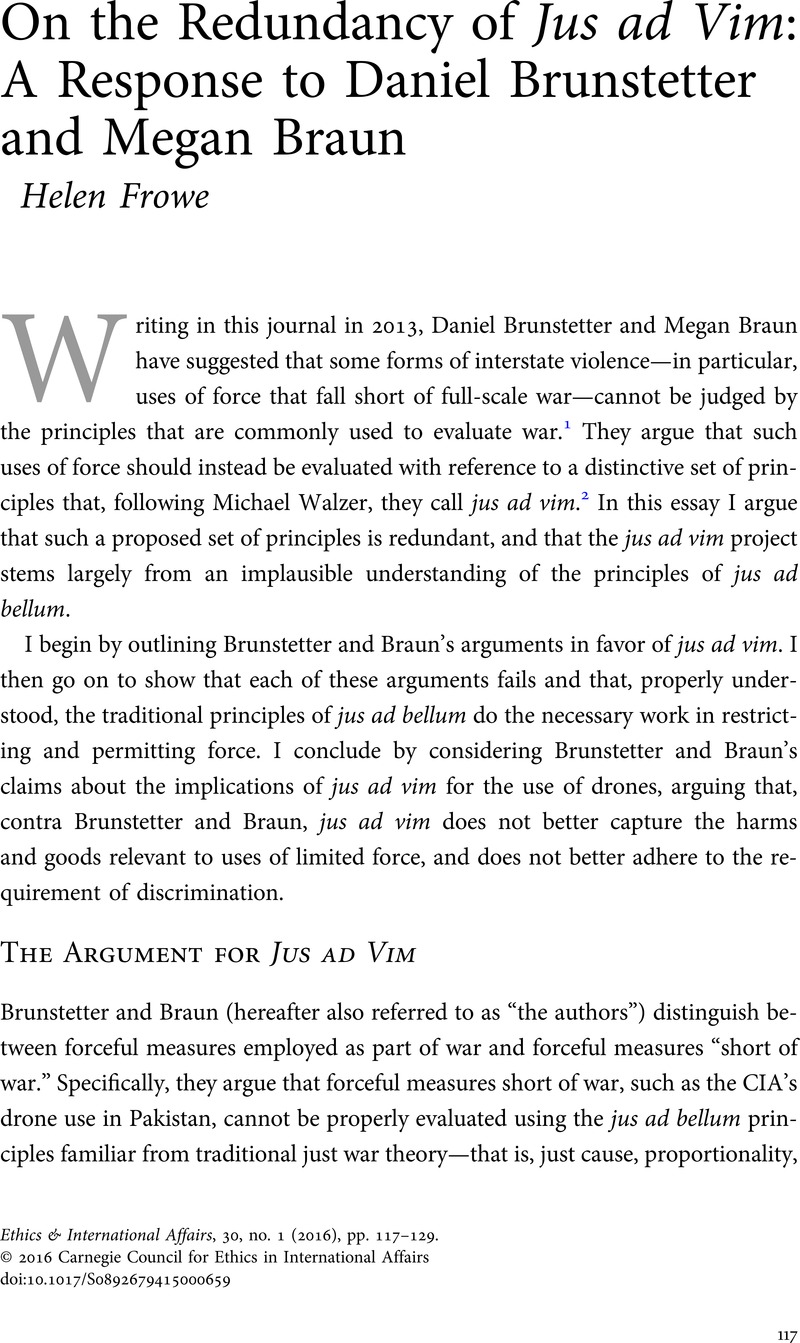Article contents
On the Redundancy of Jus ad Vim: A Response to Daniel Brunstetter and Megan Braun
Published online by Cambridge University Press: 10 March 2016
Abstract

- Type
- Response
- Information
- Copyright
- Copyright © Carnegie Council for Ethics in International Affairs 2016
References
NOTES
1 Brunstetter, Daniel and Braun, Megan, “From Jus ad Bellum to Jus ad Vim: Recalibrating our Understanding of the Moral Use of Force,” Ethics & International Affairs 27, no. 1 (2013), pp. 87–106 CrossRefGoogle Scholar; and Braun, Megan and Brunstetter, Daniel, “Rethinking the Criterion for Assessing CIA-Targeted Killings: Drones, Proportionality and Jus ad Vim ,” Journal of Military Ethics 12, no. 4 (2013), pp. 304–24CrossRefGoogle Scholar.
2 Michael Walzer, Just and Unjust Wars (New York: Basic Books, 1977), pp. xv–xvi. I focus here on the most developed account of jus ad vim, as defended by Brunstetter and Braun. Other proponents of jus ad vim include Brandt S. Ford, e.g., his “Jus ad vim and the Just Use of Lethal Force-Short-of-War,” in Fritz Allhoff, Nicholas Evans, and Adam Henschke, eds., Routledge Handbook of Ethics and War (Abingdon, U.K.: Routledge, 2013), and Jai Galloit. See also Enemark, Christian, “Drones, Risk and Perpetual Force,” Ethics and International Affairs 28, no. 3 (2014)CrossRefGoogle Scholar.
3 The actual phrase they use is “fails to offer sufficient leverage” (Brunstetter and Braun, p. 88) for assessing jus ad vim actions, but this is a bit unhappy. It makes it sound as if they are trying to shape the principles so that they deliver some (independently determined) “right” result in certain cases. I take my phrasing to be more neutral.
4 Brunstetter and Braun, p. 96.
5 Ibid.
6 Ibid., p. 97.
7 Ibid., p. 99.
8 Ibid.
9 Braun and Brunstetter, p. 306.
10 Ibid., p. 317.
11 Pattison, as cited in Brunstetter and Braun, p. 99. Pattison tells me that Brunstetter and Braun have misunderstood his view, and that he does not think jus ad bellum a one-off judgment. However, all that matters for my purposes here is that Brunstetter and Braun clearly think Pattison would be correct to view jus ad bellum as a one-off judgment.
12 See, for example, Helen Frowe, The Ethics of War and Peace: An Introduction (Abingdon, U.K.: Routledge, 2011), p. 54; Fabre, Cécile, “Guns, Food and Liability to Attack in War,” Ethics 120, no. 1 (2009), pp. 36–63 CrossRefGoogle Scholar, at pp. 49 and 57; Seth Lazar, “War's Ending and the Structure of Just War Theory” (forthcoming); Darrel Moellendorf's work on jus ex bello and David Rodin's work on jus terminatio, e.g., “War Termination and the Liability of Soldiers for the Crime of Aggression,” in Carsten Stahn and Jann Kleffner, eds., Jus Post Bellum: Toward a Law of Transition from Conflict to Peace (The Hague: T.M.C. Asser, 2008).
13 There arise here difficult questions about “sunk costs,” of course. But the point is that however we judge the proportionality of war, it remains true that if it becomes disproportionate to the just cause, it becomes unjust.
14 David Rodin, “The Myth of National Self-Defence,” in Seth Lazar and Cécile Fabre, eds., The Morality of Defensive War (New York: Oxford University Press, 2014).
15 See Helen Frowe, Defensive Killing (New York: Oxford University Press, 2014); and Helen Frowe, “Can Reductive Individualists Allow Defense Against Political Aggression?” in David Sobel, Peter Vallentyne, and Steven Wall, eds., Oxford Studies in Political Philosophy, Vol. 1 (Oxford: Oxford University Press, 2015), pp. 173–93.
16 However, Rodin argues that when it comes to defensive war, the discount that ordinarily applies to mediated harms is discounted because we have a duty of care to our fellow citizens. For an argument that this is a mistake, see Frowe, Defensive Killing, ch. 5.
17 See Jonathan Parry, “Civil War and Revolution,” in Seth Lazar and Helen Frowe, The Oxford Handbook of Ethics of War (New York: Oxford University Press, forthcoming).
18 Walzer, Just and Unjust Wars, p. 127; and Henry Shue, “Do We Need a ‘Morality of War’?” in David Rodin and Henry Shue, eds., Just and Unjust Warriors: The Moral and Legal Status of Soldiers (New York: Oxford University Press: 2008).
19 Braun and Brunstetter, p. 318.
20 Ibid., p. 319.
21 Brunstetter and Braun, p. 99.
22 McMahan, Jeff, “Just Cause for War,” Ethics & International Affairs 19, no. 3 (2005), pp. 11 CrossRefGoogle Scholar and 19.
23 On environmental damage, see the Geneva Convention, AP 1, Art. (35) (3) and AP 1, Art. (55) (1). The Hague Convention for the Protection of Cultural Property in the Event of Armed Conflict (Art. 4.1) enjoins parties “to respect cultural property situated within their own territory as well as within the territory of other High Contracting Parties by refraining from any use of the property and its immediate surroundings or of the appliances in use for its protection for purposes which are likely to expose it to destruction or damage in the event of armed conflict; and by refraining from any act of hostility directed against such property.” Art. 4.2 stipulates that the “obligations mentioned in paragraph I of the present Article may be waived only in cases where military necessity imperatively requires such a waiver.” Article 50 of the Geneva Convention prohibits “extensive destruction and appropriation of property, not justified by military necessity and carried out unlawfully and wantonly.”
24 Brunstetter and Braun, p. 101.
- 7
- Cited by




